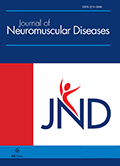Authors: Takahashi, Junichiro | Mori-Yoshimura, Madoka | Ariga, Hajime | Sato, Noriko | Nishino, Ichizo | Takahashi, Yuji
Article Type:
Research Article
Abstract:
Purpose: Chilaiditi’s sign (CS), hepatodiaphragmatic interposition of the intestine, was caused by morphological abnormalities such as diaphragmatic atrophy, intestinal dilation, and liver atrophy. The sign is potentially important due to associations with clinically recurrent abdominal pain or even colonic volvulus. Late-onset Pompe disease (LOPD) could have the high prevalence of CS because of widened hepatodiaphragmatic space, following diaphragmatic atrophy, and the abnormal dilation of intestine caused by glycogen accumulation in smooth muscle of intestine. Our aim was to investigate the prevalence of CS in LOPD, and to identify the risk factors of CS in LOPD patients. Methods: Medical
…records of genetically confirmed patients of Pompe disease at the National Center Hospital, National Center of Neurology and Psychiatry were retrospectively reviewed. We evaluated CS using chest X-ray (CXR) and abdominal CT and assessed the prevalence of CS in LOPD patients. We also divided the patients into two groups, CS and non-CS group, and evaluated the factor associated with CS compared to clinical variables between groups. Results: Three of seven (43%) were detected in CS. CS group (P5-7) and non-CS group (P1-4) were obtained. In comparison of clinical variables, the severity of atrophy in right diaphragms was significantly higher in CS than non-CS groups (p = 0.029). Also, the frequency of abnormal position of right diaphragm and liver, and abnormally dilated bowel was seen in all of CS patients, but none of non-CS patient (p = 0.029, each). Conclusion: In LOPD patients, the prevalence of CS was much higher of 43%, compared to healthy groups, or even in similarly respiratory muscle impaired neuromuscular diseases. The anatomically abnormal position of diaphragm and liver, atrophy and fat infiltration of diaphragms, and abnormally dilated bowel were significantly associated with CS in LOPD. We should pay more attention to CXR or abdominal CT as follow up in LOPD patients.
Show more
Keywords: Late-onset Pompe disease, Chilaiditi’s sign, intestinal volvulus, non-invasive positive pressure ventilation, computed tomography, Chest X-Ray
DOI: 10.3233/JND-220792
Citation: Journal of Neuromuscular Diseases,
vol. 9, no. 5, pp. 619-627, 2022
Price: EUR 27.50





